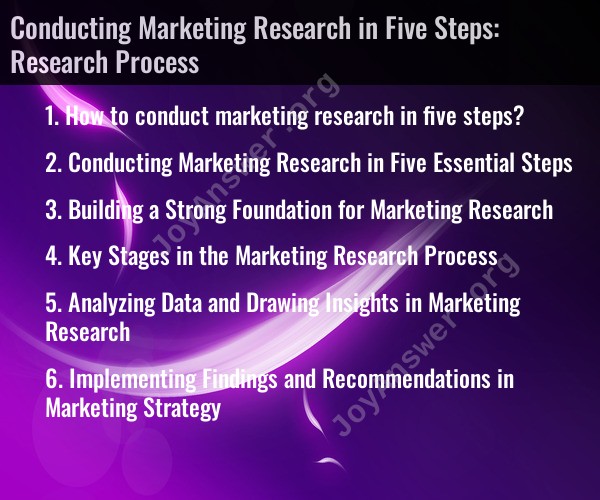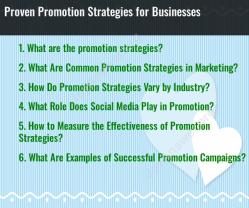How to conduct marketing research in five steps?
Conducting marketing research is a structured process that involves gathering, analyzing, and interpreting data to make informed marketing decisions. While there are many approaches to marketing research, here's a simplified five-step process to guide you through the essential stages:
Step 1: Define the Problem and Research Objectives
- Start by clearly defining the problem or question you want to address through research. What specific information or insights are you seeking?
- Set clear research objectives that outline what you intend to achieve with the research. These objectives should be specific, measurable, and time-bound.
Step 2: Design the Research Plan
- Determine the research methodology and design. This involves choosing the appropriate research approach, whether it's qualitative, quantitative, or a mix of both.
- Select data collection methods such as surveys, interviews, observations, focus groups, or secondary data analysis. Consider the most suitable techniques for your research objectives.
- Develop a sampling plan if your research involves collecting data from a subset of the target population. Define the target population and select a sample size.
- Create a data collection instrument, such as a questionnaire or interview guide, if applicable. Ensure it aligns with your research objectives and is user-friendly for participants.
- Outline the timeline and budget for your research project.
Step 3: Collect Data
- Execute the data collection phase of your research plan. This involves conducting surveys, interviews, observations, or any other data collection methods you've chosen.
- Ensure data is collected accurately and consistently. Pay attention to quality control, and consider pre-testing data collection instruments if necessary.
- Be mindful of ethical considerations, such as obtaining informed consent from participants and maintaining privacy and confidentiality.
Step 4: Analyze and Interpret Data
- Once data is collected, it's time to analyze it. Depending on the research methodology, this may involve statistical analysis, content analysis, or other techniques.
- Interpret the data to derive meaningful insights and answers to your research questions. Look for patterns, trends, and relationships in the data.
- Keep the research objectives in mind while analyzing the data to ensure you're addressing the initial problem or questions.
Step 5: Report Findings and Make Recommendations
- Prepare a research report that summarizes the findings, analysis, and conclusions. The report should be clear, concise, and easy to understand.
- Present the report to relevant stakeholders, such as management or decision-makers. Use visuals like charts and graphs to illustrate key findings.
- Provide actionable recommendations based on the research results. These recommendations should help address the problem or decision you initially identified in Step 1.
Remember that marketing research is often an iterative process, and these steps may be revisited as you gather more information and insights. Additionally, the specific details of your research process may vary based on the complexity of the research project and your organization's needs. It's essential to tailor your approach to the specific research objectives and available resources.
Conducting Marketing Research in Five Essential Steps
Marketing research is the process of collecting, analyzing, and interpreting data to help businesses make informed marketing decisions. It is a critical component of any successful marketing strategy, as it provides insights into the needs, wants, and behaviors of target consumers.
Here are five essential steps for conducting marketing research:
1. Define the research problem or objective. What do you need to know to make a better marketing decision?2. Develop a research plan. This includes identifying the research methods, data collection techniques, and sampling procedures that will be used.3. Collect the data. This can be done through primary research (e.g., surveys, interviews, focus groups) or secondary research (e.g., industry reports, government data).4. Analyze the data. This involves using statistical methods and other tools to identify patterns and trends in the data.5. Interpret the findings and draw conclusions. What do the results of the research mean for your marketing strategy?
Building a Strong Foundation for Marketing Research
To build a strong foundation for marketing research, it is important to:
- Understand the key concepts and principles of marketing research. This includes understanding the different research methods, data collection techniques, and sampling procedures.
- Identify the relevant sources of data. This includes both primary and secondary data sources.
- Develop a research design that is appropriate for the research problem or objective. The research design should be tailored to the specific needs of the study.
- Collect data in a systematic and rigorous manner. This is essential for ensuring the quality and reliability of the research findings.
Key Stages in the Marketing Research Process
The marketing research process can be divided into five key stages:
1. Planning: This involves defining the research problem or objective and developing a research plan.2. Data collection: This involves collecting data from primary and secondary sources.3. Data preparation and cleaning: This involves cleaning and organizing the data so that it can be analyzed.4. Data analysis: This involves using statistical methods and other tools to identify patterns and trends in the data.5. Interpretation and reporting: This involves interpreting the research findings and drawing conclusions.
Analyzing Data and Drawing Insights in Marketing Research
Once the data has been collected and prepared, it is important to analyze it carefully to draw insights that can be used to inform marketing decisions.
There are a variety of data analysis techniques that can be used, depending on the type of data and the research objectives. Some common data analysis techniques include:
- Descriptive statistics: Descriptive statistics are used to summarize and describe data.
- Inferential statistics: Inferential statistics are used to draw conclusions about a population based on data collected from a sample.
- Regression analysis: Regression analysis is used to identify relationships between variables.
- Clustering: Clustering is used to group similar data points together.
- Machine learning: Machine learning algorithms can be used to identify patterns and trends in data that are difficult to spot using traditional statistical methods.
Implementing Findings and Recommendations in Marketing Strategy
The final step in the marketing research process is to implement the findings and recommendations in the marketing strategy.
This involves translating the research findings into actionable insights that can be used to improve marketing campaigns, develop new products and services, and better understand the target market.
It is important to communicate the research findings to all relevant stakeholders, including marketing managers, product managers, and sales teams. This will ensure that the research findings are used effectively to improve the overall marketing strategy.
By following these five essential steps, businesses can conduct effective marketing research that will help them to make better marketing decisions and achieve their business goals.













